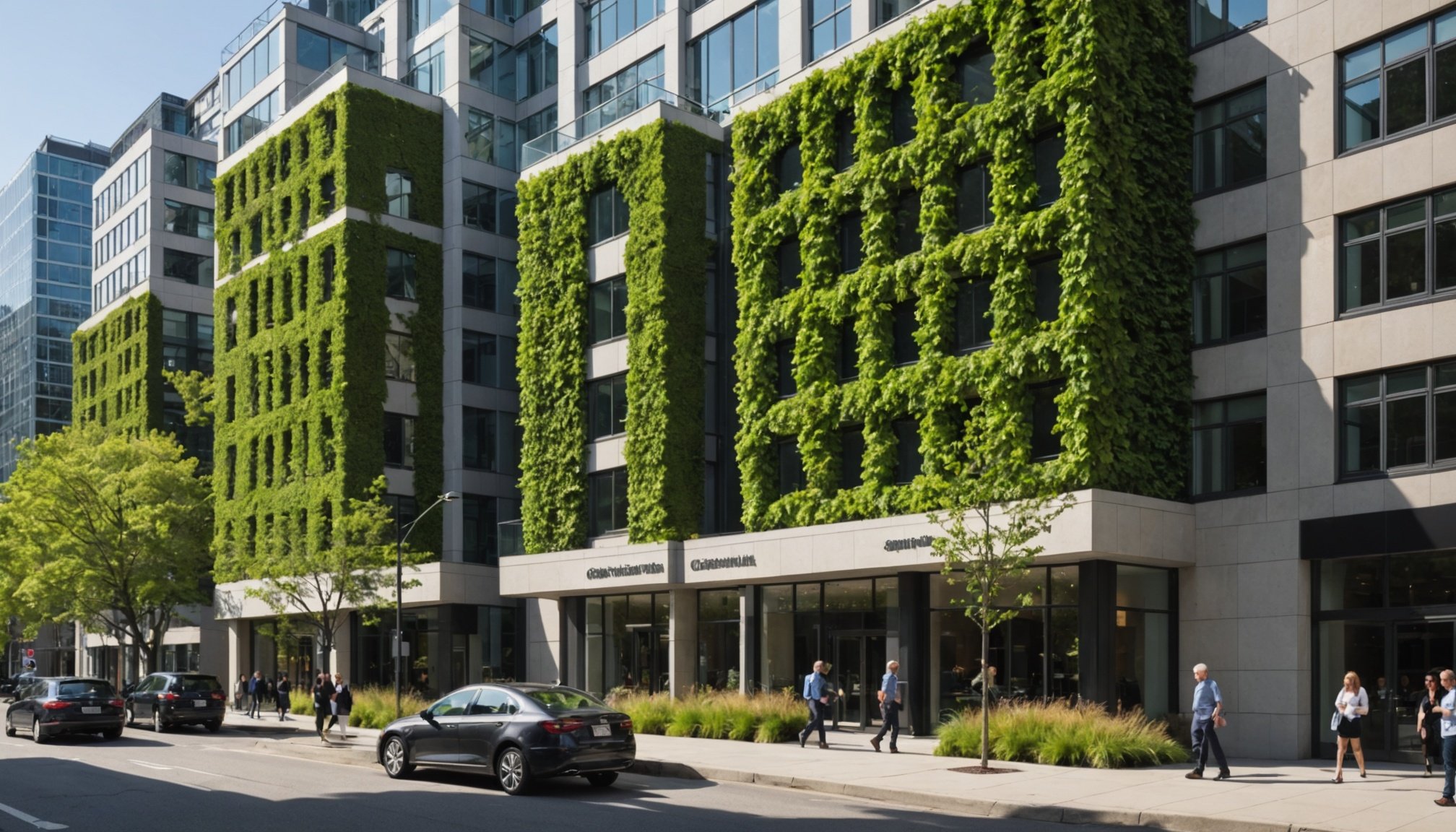Financial Benefits of Green Building Standards
When examining green building standards, a primary consideration is the financial incentives they offer. Harnessing energy efficiency measures allows for significant cost savings in both the short and long term. The reduction in energy consumption can lead to lower utility bills, which is a direct financial gain for property owners and tenants.
One of the greatest financial advantages of green building lies in the substantial return on investment (ROI). Projects that incorporate sustainable materials and technologies often see improved building performance and increased property value. A typical ROI analysis for green investments considers lowered maintenance costs and enhanced energy efficiency, providing a compelling case for sustainability.
Also to see : Key Elements for Developing Cost-Effective Housing Solutions in Densely Populated Cities
For instance, cities like Vancouver and Portland have seen remarkable financial outcomes by adopting green building standards. These cities not only witness decreased operational costs but also benefit from increased market demand for eco-friendly buildings, driving up property values.
To summarise, embracing green building standards is not only environmentally responsible but also financially rewarding. By investing in sustainability, stakeholders from individual property owners to entire cities can experience significant economic advantages, encouraging widespread adoption of these beneficial practices.
Topic to read : Crafting Age-Inclusive Urban Spaces: The Ultimate Guide to Senior-Friendly Public Environments
Government Incentives and Grants
Navigating the landscape of government subsidies, tax incentives, and financial support can seem daunting. However, these offers are essential to maximise savings when adopting green building practices. By leveraging these resources, both developers and property owners can offset initial costs, ensuring an attractive return on investment.
Overview of available incentives
Government subsidies are primarily provided to encourage advances in sustainable architecture. They can range from direct funding to reduced interest loans, tailored to promote environmentally responsible development.
Tax credits for sustainable building practices
Certain regions offer tax incentives for adopting green technologies. These credits serve as financial rewards that lower tax liability, ultimately making eco-friendly solutions less costly in the long run.
Grants for retrofitting existing structures
Retrofitting existing buildings can be costly, but grants support these transformations, easing financial burdens. It is crucial to understand and pursue available grants, as they are pivotal in making such projects feasible.
Proactively pursuing government support is vital for any entity aiming to incorporate sustainable methods. By diligently accessing these incentives, the path to sustainable development becomes not only practical but financially attainable.
Case Studies of Successful Implementation
Exploring urban development case studies reveals insights into the advantages of implementing green building standards. Cities that have embraced sustainability efforts offer a wealth of examples demonstrating successful green initiatives.
Notable cities like Copenhagen and Singapore stand out for their pioneering efforts. In Copenhagen, ambitious carbon-neutral goals have led to innovative projects reducing emissions while enhancing livability. Singapore’s commitment to sustainability is evident through its impressive green spaces and energy-efficient buildings. These examples underscore the transformative power of best practices when it comes to green development.
Analysis of specific projects further illuminates the financial benefits of going green. Projects in these cities illustrate how eco-friendly designs not only lead to significant energy cost reductions but also boost property values and attract environmentally conscious investors. The combination of technology, innovative design, and policy support are key factors contributing to their success.
The lessons learned from these urban development case studies serve as valuable guides for cities aiming to adopt similar green initiatives. By following these best practices, other urban areas can leverage their resources effectively, resulting in both economic and environmental gains that promote long-term growth.
Sustainability Impacts on Local Economies
Understanding how implementing green building standards affects local economy benefits is crucial for decision-makers. A significant advantage lies in the creation of green jobs. Jobs emerge through construction and maintenance projects that require new expertise in sustainable methods, driving employment in this sector.
Job creation from green building projects
Developing eco-friendly infrastructure opens opportunities for various professionals. Architects, engineers, and skilled labourers trained in sustainable practices are in demand, enhancing local employment rates. This shift not only provides immediate jobs but also fosters long-term career paths in green technology fields.
Economic impacts of improved community sustainability
Green building projects contribute to the local economy by promoting better community development. Investing in sustainable practices often improves property values, attracts eco-conscious residents, and enhances the overall quality of life, creating a virtuous economic cycle. Communities become more appealing, generating increased business for local retailers and service providers.
Long-term growth prospects for cities adopting green measures
Cities embracing green standards often see sustained economic growth. By focusing on sustainability, urban planners tap into enhanced local business revenue and attract investors prioritising environmentally responsible portfolios. This trend is essential for long-term urban prosperity and resilience against future economic and environmental challenges.
Financial Models for Green Investments
In the realm of green investments, financial modeling plays a crucial role in assessing potential returns and risks. Green financing often hinges on comprehensive investment analysis, ensuring that every stakeholder understands the economic viability and long-term benefits.
When delving into financial modeling for green building projects, several key metrics take center stage. These include the Net Present Value (NPV) and the Internal Rate of Return (IRR), essential indicators of financial health and feasibility. Understanding these metrics allows developers to quantify benefits from reduced operational costs and enhanced energy efficiencies over time.
A successful investment analysis also involves meticulous cash flow projections, incorporating potential savings from energy-efficient technologies. By doing so, one can illuminate the fiscal benefits accrued from sustainable practices. Moreover, leveraging green financing tools such as green bonds or sustainability-linked loans can be instrumental in funding projects effectively.
To present financial data compellingly, it’s crucial to translate technical metrics into insights that resonate with stakeholders. Providing visualizations like graphs or charts can make investment analysis accessible and encourage informed decision-making. This strategic approach helps secure necessary funding and buy-in for sustainable infrastructure initiatives.
Actionable Steps for City Planners and Developers
When considering implementation strategies for green initiatives, city planners and developers must focus on designing public policies that promote sustainable practices. Prioritising city planning that integrates green building standards ensures projects are not only environmentally sound but also economically viable.
Steps to Design Public Policies
Planners should focus on creating incentives for developers to adopt green practices. This could involve streamlined permitting processes for projects that utilise sustainable materials and technologies. Additionally, introducing green initiatives into zoning regulations can drive developers to construct eco-friendly buildings, leading to a widespread adoption of environmentally responsible methods.
Engaging with Stakeholders
Successful green initiatives require collaboration with various stakeholders. Developers, community leaders, and environmental organisations should be actively engaged. This creates a platform for discussing environmental goals, addressing challenges, and ensuring all parties support the shift towards sustainability.
Tools and Resources for Effective Implementation
Resources like databases of best practices, guidelines for sustainable design, and financial tools are essential. These offer practical solutions and insights into adopting green standards effectively. Employing these tools empowers cities to meet sustainability goals and benefit economically, socially, and environmentally. By embracing these steps, urban areas can transition smoothly to greener futures.





